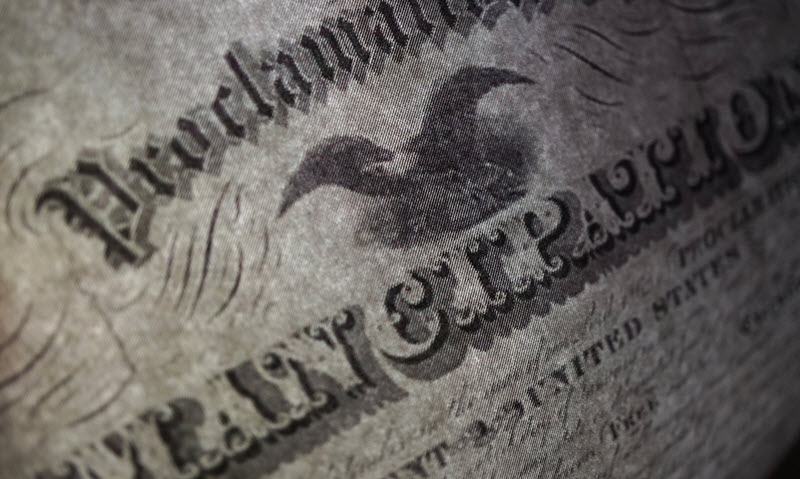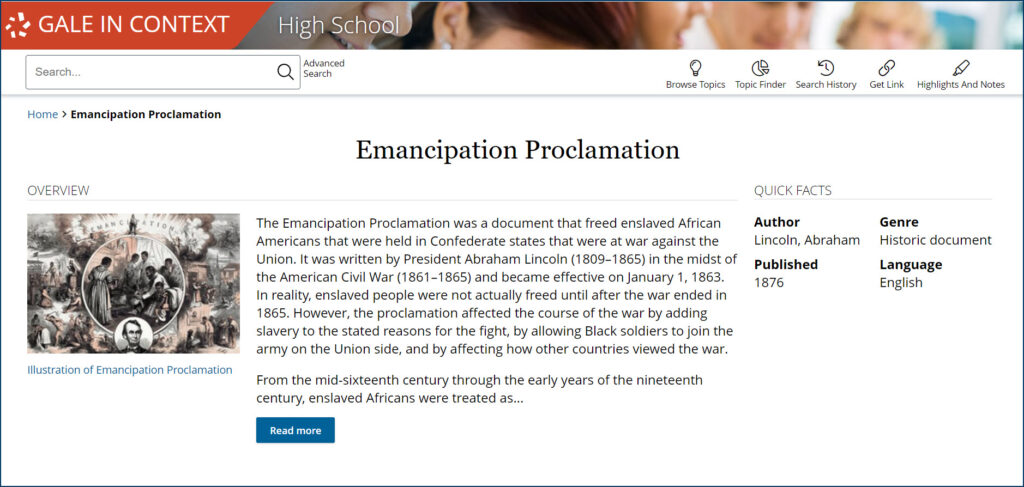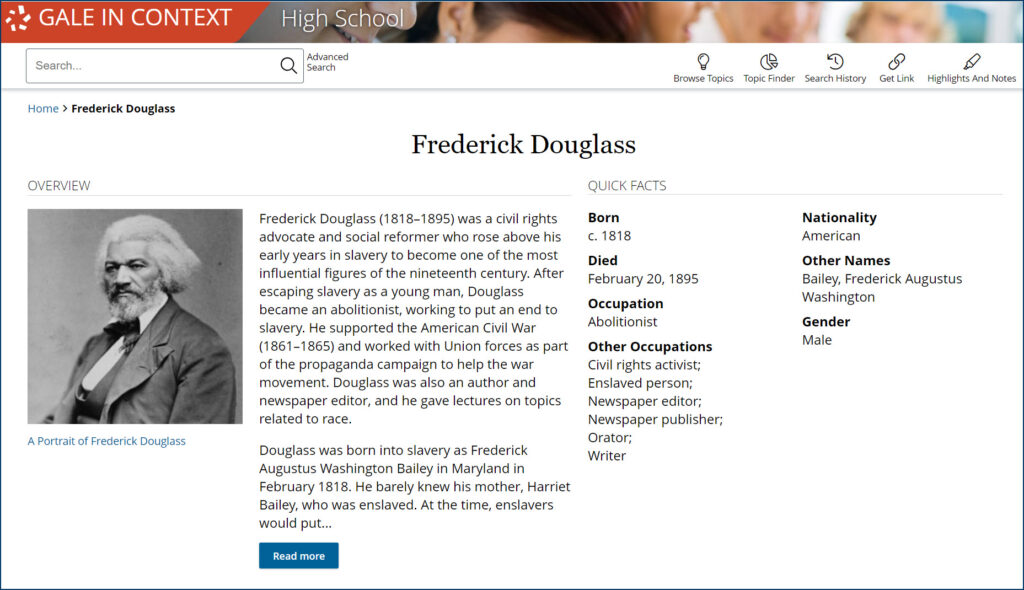| By Gale Staff |
Months before Abraham Lincoln signed the Emancipation Proclamation into law, he proposed a resolution offering financial compensation for states that adopted a gradual emancipation model. While the resolution passed in Congress, it was unpopular with the Confederate border states, none of which accepted the deal.
On April 16, 1862, the DC Compensated Emancipation Act, sponsored by Massachusetts Senator Henry Wilson and signed by Lincoln, liberated 3,100 enslaved persons. The passing of the DC Compensated Emancipation Act signaled the beginning of the end of slavery in the United States. Eight months later, on January 1, 1963, the Emancipation Proclamation freed all enslaved persons in the Confederate States.
However, states loyal to the Union were allowed to continue practicing slavery, as were those that had come under Union control during the Civil War. This meant that Washington, DC, was under no legal obligation to pursue emancipation. Rather, emancipation came after decades of abolitionists and formerly enslaved persons petitioning to end the “national shame” of allowing slavery to continue in the capital.
The city commemorates this seminal step toward abolition by celebrating DC Emancipation Day on April 16. The event’s highlight is a parade down Pennsylvania Avenue, but the entire weekend is dedicated to coming together as a community for concerts featuring Black artists, fireworks, picnics, and guided discussions held at the Smithsonian National Museum of African American History and Culture.
With DC Emancipation Day coming up, educators can use the holiday as a launching point to engage high school students in research and discussion to stretch their critical thinking by considering two points of contention: First, Lincoln’s motivation for freeing enslaved persons. Second, whether the Emancipation Memorial in Washington, DC, should be replaced with one that honors the hard-fought battle that enslaved people waged to claim their freedom.
The Gale In Context: High School Emancipation Proclamation portal encourages students to dig into diverse contemporary and historical viewpoints. The easy-to-navigate database is home to a wealth of resources, from helpful infographics illustrating a century’s worth of slavery laws to primary source letters from enslaved peoples. Each offers translation and text-to-speech settings, so every student gets exactly the support they need to access the materials in the language and format they learn best.
Lincoln’s Motives for Emancipation
It may come as a surprise that the Emancipation Proclamation had abolitionist critics, but there are some rarely discussed controversies about Lincoln’s motives, giving it what Louis P. Masur calls a “rocky reputation.” He further explains, “It was roundly and predictably condemned by Democratic opponents, who characterized it as a brash and sweeping abuse of presidential power. Perhaps less predictably, Northern abolitionists also condemned it. They argued that it didn’t do enough, didn’t go far enough.”
On the one hand, the anti-abolitionist Democrats of the time saw it as a violation of the Constitution. Though the founding fathers never mentioned slavery directly, the Constitution upheld the Three-Fifths Compromise and required that enslaved persons who escaped be returned to their enslavers. By issuing the Emancipation Proclamation, Lincoln would technically violate a slaveholder’s Constitutional rights, as morally reprehensible as those rights were.
On the other side of the aisle, the abolitionists decried Lincoln’s offer to compensate slaveholders in states that agreed to his 1862 resolution. How could he reward slaveholders with $300 for each enslaved person but only offer up to $100 to the freed people?
When Lincoln issued the Emancipation Proclamation a year later, abolitionists then said it was just a ploy to strongarm the South, leaving thousands of enslaved persons in oppression in the Union-loyal states of Delaware, Kentucky, Maryland, and Missouri.
As discussed in the Gale In Context: High School article on Abraham Lincoln, The London Times summarizes one of the most common criticisms of the time, writing, “That this measure is no homage to principle or conviction, but merely a means of raising up a domestic enemy against the Southerners in the midst of their Southern states, is abundantly proved from the fact that slavery, so odious in Alabama, is tolerated in Kentucky.” It would take until the ratification of the 13th Amendment on December 6, 1865, for slavery to be fully abolished.
As Masur argues, though, the truth may be somewhere in between—a compromise that balanced the Union’s military needs and a push toward abolition that would have a domino effect once the danger of secession had passed. This ambiguity invites learners to make arguments about Lincoln’s approach and what, if anything, he should have done differently.
Discussion Idea: While we can’t say with certainty whether Lincoln’s actions were reflective of his beliefs, a flex of executive power, or a bit of both, your class could engage in a discussion of whether those motivations matter. Consider the following questions:
1. Did Lincoln do the right thing at the time? What factors did he have to consider?
2. What do they think would have happened if he had pushed hard in one direction—either demanding emancipation in all states or backing off of the idea altogether to avoid violating the Constitution?
3. Would knowing Lincoln’s motivation affect his legacy, or is the result what’s most important?
The Emancipation Memorial
With the recent protests regarding Confederate statues, it might come as a surprise that a bronze memorial of Abraham Lincoln holding the Emancipation Proclamation also came under fire. It’s even stranger when you consider that it was commissioned by Charlotte Scott, a formerly enslaved woman who used the first $5 she earned in freedom to campaign for its construction.
The issue, however, is the person at Lincoln’s feet: a black man named Archer Alexander, who escaped slavery several times only to be recaptured. T. S. Eliot’s grandfather, Rev. William Greenleaf Eliot, befriended Alexander, the great-great-great grandfather of Muhammad Ali, and brought his story into the national consciousness when he wrote The Story of Archer Alexander: From Slavery to Freedom in 1885.
It was Eliot, too, who gave photos of Alexander to the sculptor Thomas Ball and encouraged him to use the man’s likeness as inspiration for the memorial, erected in Lincoln Park in Washington, DC.
Upon seeing the memorial for the first time, Frederick Douglass wrote to the New Republican newspaper, “The Negro here, though rising, is still on his knees and nude. What I want to see before I die is a monument representing the Negro, not couchant on his knees like a 4-footed animal but erect on his feet like a man.”
Douglass’s thoughts on the matter are similarly reflected in modern discourse, with historian and author Arica L. Coleman stating, “It gives the impression that we were just sitting around waiting for Lincoln to free us. That is not true . . . Many of the enslaved broke their own chains. And that was the case with Alexander.”
On February 1, 2023, Congresswoman Eleanor Holmes Norton, representing the District of Columbia, introduced a bill urging its removal. Her introductory statement echoes the same dismay and frustration as Douglass’s letter:
“Although formerly enslaved Americans paid for this statue, it was designed and sculpted without their input, and it shows . . . fail[ing] to recognize African Americans’ agency in pressing for their own emancipation.”
However, not everyone agrees that the statue needs to be removed.
Yale history professor David Blight believes that many Confederate statues should indeed come down but doesn’t count the Emancipation Memorial among them. When asked about the difference, he stated, “There’s a much larger story about that monument, about its unveiling, about what it meant at that time.”
Discussion Idea: Critics of the Emancipation Memorial fall into three camps: Those who support complete removal, those who support leaving it up but adding an additional memorial without the racist imagery, and those leaving the memorial as-is.
Encourage your learners to explore the resources available in Gale In Context: High School more thoroughly and formulate an argument for the best solution. Do they feel that this memorial is different from the Confederate memorials? Does the intention behind the depiction matter more than the symbolism, or vice versa?
Gale In Context: High School: Bringing Diversity to the Historical Record
DC Emancipation Day continues to be a time for celebration and contemplation in the nation’s capital.
Between family picnics and fireworks, events like the Ford Theater’s DC Emancipation Day webinar and “From Franklin Park to Mount Vernon Square,” a walking tour following the original Emancipation Day parade route in 1866, remind us to rally for the causes they believe in, just as those bold Washingtonians before us.
If taking a trip to the capital to join in the celebration isn’t possible, Gale In Context: High School brings resources about the DC Emancipation Day together into one convenient platform. These offer a diverse and inclusive account of events, encouraging students to look deeper and seek out voices that are so often omitted—including those of the enslaved persons whose fight for their freedom has been too long ignored.
If you don’t already have a Gale In Context: High School subscription, reach out to your local sales representative to learn more or request a trial today!



